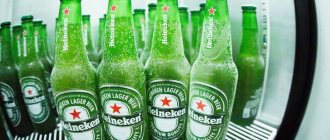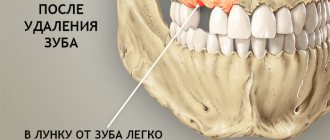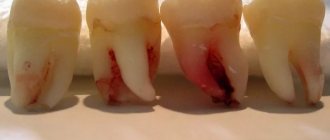From this article you will learn:
- Why you can’t eat after tooth extraction
- Is it possible to smoke after tooth extraction?
- When and what can you eat after tooth extraction?
- Alcohol before surgery - possible consequences
- Possible complications if you ignore the ban
- Alcohol after dental treatment
- What is allowed to drink after tooth extraction?
- How long after can you drink alcohol?
- Alcohol after dental implantation
- Other complications in which drinking alcohol is prohibited
Tooth extraction, according to dentists, is an operation of despair. Long gone are the days when it was easier to remove a molar than to treat it. Now doctors are fighting to the last to save all the teeth. They even try not to remove wisdom teeth without compelling evidence.
Tooth extraction is a physically and mentally difficult operation for the patient. Therefore, many people try to relieve stress with alcohol. Often this decision leads to serious complications.
Alcohol after dental treatment
The effect of alcohol on a treated tooth
How long after dental treatment can you drink alcohol?
Is it possible to drink carbonated or foamy drinks after dental treatment?
Is it possible to smoke after surgery?
A toothache can strike at the most unexpected moment, including before a planned feast. Is it possible to drink alcohol after dental treatment? What consequences can this lead to?
How long should you not eat after having a filling installed?
If a filling made of chemical composites is installed, then you should refrain from eating and drinking for 2 hours. This is due to the fact that the material requires a certain time for final shrinkage and hardening.
If a “light” composite filling is installed, you can drink immediately, but you should abstain from food for 1.5-2 hours. But the reason is not in the material (it hardens a few seconds after application), but in anesthesia - with reduced sensitivity of the mucous membranes during eating, you can injure the tongue and mucous membranes of the cheeks on the inside.
During the day after the filling is installed, you should only eat warm foods - excessively hot or cold foods can lead to changes in the shape of the filling. It is necessary to chew food on the opposite side for the first day - this will allow the material to fully “adhere” to the tissues and take the desired shape, without the risk of damage.
The effect of alcohol on a treated tooth
Some people think that alcohol after dental treatment additionally disinfects the oral cavity, but doctors say the opposite. After dental treatment, especially after treatment of pulpitis or periodontitis, the body needs rest. Not only the daily routine should be gentle, but also the diet, so at this time it is better to give up alcoholic beverages.
Let's tell you why.
- Alcohol can cause bleeding because alcohol dilates blood vessels and increases blood pressure.
- When drinking alcohol, the oral mucosa is irritated, the healing process slows down, and the risk of inflammation increases.
- Alcohol increases the load on the cardiovascular system and liver.
- Alcoholic drinks in combination with an anesthetic can cause headache, weakness, and convulsions.
Despite the fact that the effect of anesthesia wears off on average after two hours, the breakdown products continue to remain in the body for several more days.
Alcohol before surgery: possible consequences
The strict ban on drinking alcohol before tooth extraction is due to many factors that can have an extremely negative impact on both the patient’s health and the course of the operation. You can see a number of problems below.
- Weak or completely absent effect of anesthesia;
- The recovery process after surgery takes much longer;
- Increased risk of inflammatory processes;
- Intoxication and the body’s rejecting reaction to medications.
IMPORTANT!
If a patient comes to an appointment while intoxicated, the doctor has the right to refuse admission. This is due to the fact that a drunk person can negatively affect the progress of the operation.
Is it possible to drink carbonated or foamy drinks after dental treatment?
Gas is a constant irritant to the tooth, and foamy drinks (for example, kvass) contain yeast, which can get into the wound and cause discomfort. In addition, in the first days after tooth extraction, it is not recommended to drink drinks from straws. When sucking any drink, a vacuum is created in the mouth, which can tear a blood clot out of the hole.
If the doctor has placed a temporary filling
A temporary filling is made of a fragile material and is placed for several days to close the tooth cavity with the medicine placed inside. The patient’s task is not to damage the temporary filling until the next visit to the dentist:
- teeth are brushed with care; the pressure of the toothbrush on the tooth on which the temporary filling is placed should be minimal;
- It is better to exclude very hot and very cold foods and drinks. You cannot eat hot and cold at the same time;
- The chewing load on the filled tooth should be limited; it is better not to chew food with it, if possible.
How to maintain your treatment guarantee
As a rule, therapeutic treatment, that is, dental filling, is guaranteed from 6 months to 2 years - depending on the volume of work and the complexity of the situation. To maintain the guarantee, the patient must strictly follow all recommendations: do not overload the tooth, do not use it for other purposes (for example, open beer bottles), and also regularly see the doctor in accordance with the individual schedule of medical examinations. Unfortunately, many patients forget about this, and it is the last point that is the key to maintaining the guarantee for treatment.
You need to visit a doctor 1-2 times a year. During a preventive examination, the dentist will be able to make sure that the filling is in good condition and that caries does not develop again underneath it.
How to properly perform hygiene procedures
After treatment, brush the filled tooth carefully, applying minimal pressure to it. Do not use rinses containing abrasive substances and alcohol, which can increase the plasticity of the material - this will lead to a change in the shape of the filling. Also, do not use excessively hard brushes - they can leave microcracks in the material, which will quickly damage it.
In general, you should take care of teeth with fillings in a completely standard way:
- daily brushing of teeth twice a day - in the morning before breakfast and in the evening after all meals, after - rinsing the mouth with water and rinse,
- To clean the area of filled teeth after eating, it is better to replace dental floss with an irrigator. If you floss carelessly, you can touch the installed filling, especially if there are thin edges of the tooth, which will lead to its loss.
Recommendations
All alcoholic drinks contain ethyl alcohol. If you drink vodka, wine, cognac or beer, the liver takes on double the load. The body needs to absorb both the painkiller and the alcohol. The negative impact on the liver can be aggravated by the use of antibiotics, analgesics, and antihistamines. To avoid toxic shock, you need to follow these tips:
- You should avoid drinking alcohol if you are planning a dental visit on the same day.
- If your dental procedure involves the use of antibiotics, it is best to avoid drinking alcoholic beverages throughout the treatment.
- Before the appointment, it is necessary to inform the dentist about the presence of allergic reactions and medications used the day before.
- Remember that the success of a medical procedure depends on proper preparation. If you approach dental surgery irresponsibly, you may need additional anesthesia or repeated intervention.
There is no doubt that drinking strong drinks during dental anesthesia is extremely undesirable. If you want the procedure to be safe and painless, you should carefully read the above recommendations.
Don't be afraid of visiting the dentist's office. You can consult a competent specialist who will tell you how to properly prepare for the treatment process. A professional dentist will select an individual anesthetic and recommend the most effective method for a quick recovery.
Category Miscellaneous Published by kosmetik-dent
Complications
As with any other operation, some complications are possible when performing such plastic surgery, including:
- violation of the integrity of the nasal mucosa and, as a result, a constant runny nose;
- entry of the implant into the sinus and possible damage to it;
- the appearance of an oroantral type fistula;
- bleeding and inflammation in the sinuses.
It is important to note that the higher the level of professionalism of the doctor, the lower the risk of any complications.
Other bone grafting methods
There are other common types of bone grafting. There are several differences between them: the purpose of the exercise and the necessary material. Popular:
- Autotransplantation. Used in cases where it is necessary to increase the width of bone tissue. At the first stage, the doctor collects material from the patient himself, then installs the screw and secures the chips and membrane. Lastly, the gums are sutured. It is believed that autotransplantation is the most optimal method, since it rarely causes implant rejection.
- Synthetic replacement. When building up artificial teeth, a synthetic powdery material is used, which is completely hypoallergenic.
- Barrier membranes. They are used to prevent the most common complication during implantation—bone growth into the mucosa. A special membrane separates the mucous membrane from the material, which helps strengthen the installed blocks.
What to do if your gums hurt after filling
The gums in the area where the anesthesia was administered may ache for several days - this is completely normal and does not require any measures. The mucous membrane may also be slightly inflamed if special rings were used during treatment, which are placed on the tooth to form the correct shape of its crown. The gums can also be damaged if the doctor had to install the filling material in close proximity to the mucous membrane or even under it - in such a situation the gums are deliberately pushed back. Therefore, pain is a normal reaction to external intervention.
All of these conditions are variations of the norm. But if the pain intensifies, redness and swelling of the mucous membrane progresses, you need to consult a doctor.
How long should you abstain from alcohol?
To avoid dangerous consequences for the body, before visiting the dentist and after procedures with anesthesia, you need to refrain from drinking alcoholic beverages. After medical manipulations, at least 1-2 days should pass before the person drinks alcohol.
Why can our articles be trusted?
We make health information clear, accessible and relevant.
- All articles are checked by practicing doctors.
- We take scientific literature and the latest research as a basis.
- We publish detailed articles that answer all questions.
If the planned event requires a person to drink, then it is better to limit yourself to a glass of wine or one glass of vodka. This will not have a significant effect on the body and will prevent possible negative consequences. But again, you need to drink this amount of alcohol no less than a few hours after dental anesthesia.
Features of light seals
The composition of the light filling, as well as the technique of its installation, differs from other composite materials. The photopolymer contains a mixture of resins, fillers and silanes. This material hardens only under the influence of ultraviolet radiation, which affects the filling technique. To restore the integrity of the crown, the dentist applies the composition in layers, using a special blue lamp after each layer.
Photopolymer fillings have advantages over other types of composites:
- plasticity of the composition and controlled hardening - the specialist has the opportunity to apply the material without haste, which will avoid the formation of gaps or the creation of an unaesthetic surface of the dental crown;
- minimal content of toxic substances in the composition - due to the low level of toxins, there are practically no contraindications for the use of the material regarding the health status and age of the patient;
- simplified final processing - the composite can be easily polished, which makes it possible to create a smooth surface that prevents damage to the enamel of the opposite tooth, tongue and soft tissues;
- the ability to select an individual shade - the material can be almost identical in color to other teeth;
- natural shape - the plasticity of the composite allows the specialist to create the shape of a natural crown;
- service life - if the recommendations are followed, the seal will last at least 5 years.
The light filling has one significant drawback - the composite is not used when lesions are too large, or in hard-to-reach places.
Procedure options
In practice, two main types of procedure are used:
- Closed sinus lift. In parallel with the extension process, an implant is installed. This is a very convenient method, but it is not for everyone. The bone tissue must have a certain height, otherwise implantation becomes impossible. The procedure itself is quite simple: with a special tool, the doctor displaces the bottom of the sinus directly through the prosthesis bed, and then fills the void with the necessary material.
- Open sinus lift. This manipulation occurs over a long period of time. In the first stage, the dentist makes a small hole in the side of the sinus wall and fills the gap with a special material. Then, after 3-6 months, the hole opens and is loaded more heavily, since the bone has already become sufficiently strong. It is important to note that the open procedure can be performed with or without tooth augmentation.








